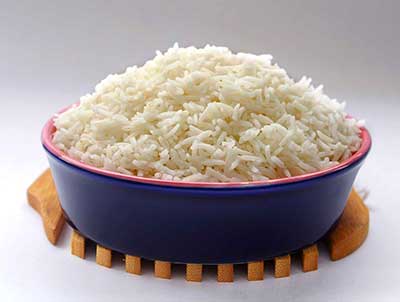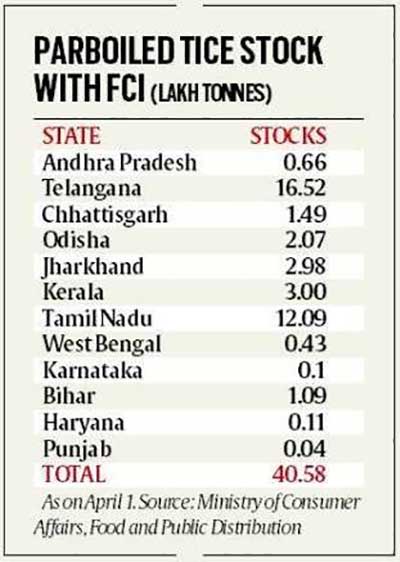Relevance: GS-3: Major crops-cropping patterns in various parts of the country, – different types of irrigation and irrigation systems storage, transport and marketing of agricultural produce and issues and related constraints.
Key Phrases: Uniform paddy procurement policy, Parboil, paddy, Food Corporation of India, chromate, soaking, steaming, milling, oxidative rancidity, deficit.
Why in News?
- Recently Telangana Chief Minister and members of his Cabinet staged a dharna at Telangana House, demanding a uniform paddy procurement policy.
- The protest came after the Centre said it was stopping the purchase of excess parboiled rice, of which Telangana is a major producer.
What is Parboiled Rice?
- The dictionary meaning of ‘parboil’ is ‘partly cooked by boiling’. Thus, the expression parboiled rice refers to rice that has been partially boiled at the paddy stage, before milling.
- Parboiling of rice is not a new practice, and has been followed in India since ancient times. However, there is no specific definition of parboiled rice of the Food Corporation of India or the Food Ministry.
- Today, there are several processes for parboiling rice.
- The Central Food Technological Research Institute (CFTRI), Mysuru,
- It uses a method in which the paddy is soaked in hot water for three hours, in contrast to the more common method in which paddy is soaked for 8 hours.
- The water is then drained and the paddy steamed for 20 minutes. Also, the paddy is dried in the shade in the method used by the CFTRI, but is sun-dried in the common method.
- The Paddy Processing Research Centre (PPRC), Thanjavur
- It follows a method known as the chromate soaking process.
- It uses chromate, a family of salt in which the anion contains both chromium and oxygen, which removes the odour from the wet rice.
- The Central Food Technological Research Institute (CFTRI), Mysuru,
- All processes generally involve three stages - soaking, steaming and drying. After passing through these stages, the paddy goes for milling.
Food Corporation Of India
- The Food Corporation of India (FCI) is a statutory body created and run by the Government of India.
- It is under the ownership of Ministry of Consumer Affairs, Food and Public Distribution, Government of India formed by the enactment of Food Corporation Act, 1964 by the Parliament of India.
- Its top official is designated as Chairman and Managing Director who is a central government civil servant of the IAS cadre.
- It was set up in 1965 with its initial headquarters at Chennai. Later this was moved to New Delhi.
- It also has regional centers in the capitals of the states.
Are All Rice Varieties Suitable for Parboiling?
- Generally, all varieties can be processed into parboiled rice, but it is ideal to use long slender varieties to prevent breakage during milling.
- However, aromatic varieties should not be parboiled because the process can make it can lose its aroma.
Benefits of Parboiling
- Parboiling makes rice tougher.
- This reduces the chances of the rice kernel breaking during milling.
- Parboiling also increases the nutrient value of the rice.
- Parboiled rice has a higher resistance to insects and fungi.
- Post-milling parboiled rice contains much greater amounts of B vitamins, minerals (especially Ca, P, and Fe), and free amino acids than raw rice.
- Parboiled grains do not mash together after cooking, thus remaining whole, and making rice suitable for making products which are canned, expanded or flaked.
Disadvantage of Parboiling
- The rice becomes darker and may smell unpleasant due to prolonged soaking.
- The final rice is more prone to oxidative rancidity.
- Besides, setting up a parboiling rice milling unit requires a higher investment than a raw rice milling unit.
- The rice husk represents a hurdle for the entire parboiling process because it has a poor thermal conductivity resulting in increased time and heat energy required for wetting and heating.
How Much is the Stock of Parboiled Rice in The Country?
- According to the Food Ministry, the total stock of parboiled rice is 40.58 lakh metric tonnes (LMT) as on April 1, 2022.
- Out of this, the highest stock is in Telangana at 16.52 LMT, followed by Tamil Nadu (12.09 LMT) and Kerala (3 LMT).
- The stock was in the range 0.04–2.92 LMT in 10 other states —Andhra Pradesh, Chhattisgarh, Odisha, Jharkhand, West Bengal, Karnataka, Bihar, Punjab and Haryana.
- The Centre will procure 1.36 LMT of parboiled rice from Telangana for the Kharif Market Season (KMS) of 2020-21.
- For the ongoing KMS 2021-22, the Centre expects to procure 5.82 LMT parboiled rice from only two states—Jharkhand (3.74LM) and Odisha (2.08 LMT).
- From the other 10 rice-producing states, including Telangana, the Ministry has no plan to procure parboiled rice. In the coming days, the total parboiled rice stock will increase to 47.76 LMT.
How high is The Demand?
- The Food Ministry pegs the parboiled rice demand at 20 LMT per annum for distribution under the National Food Security Act, 2013. According to the Ministry, the demand for parboiled rice has come down in recent years.
- Production of Parboiled Rice in other states: In the last few years, production in parboiled rice-consuming states such as Jharkhand, Kerala and Tamil Nadu has increased, resulting in less movement to the deficit states.
- Earlier, the Food Corporation of India (FCI) used to procure parboiled rice from states such as Telangana to supply to these states.
- But in recent years, parboiled rice production has increased in these states. So, the Ministry says, the current stock of parboiled rice is sufficient to meet the demand for the next two years.
Sources: Indian Express
Mains Question:
Q. What is Parboiled rice? Why centre wants to stop purchasing it? Critically examine. (250 words).










